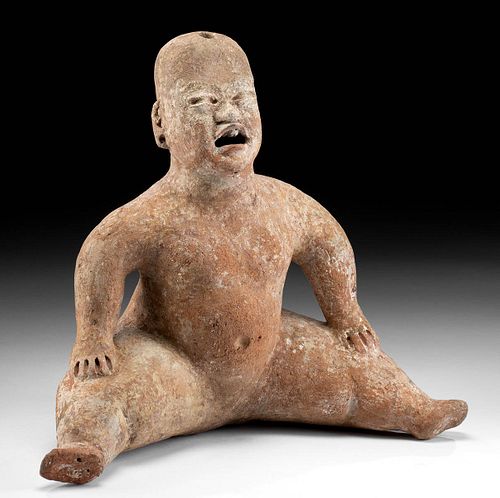Remarkable Olmec Pottery Wailing Baby Figure
Lot 142
About Seller
Artemis Gallery
686 S Taylor Ave, Ste 106
Louisville, CO 80027
United States
Selling antiquities, ancient and ethnographic art online since 1993, Artemis Gallery specializes in Classical Antiquities (Egyptian, Greek, Roman, Near Eastern), Asian, Pre-Columbian, African / Tribal / Oceanographic art. Our extensive inventory includes pottery, stone, metal, wood, glass and textil...Read more
Categories
Estimate:
$8,000 - $12,000
Absentee vs Live bid
Two ways to bid:
- Leave a max absentee bid and the platform will bid on your behalf up to your maximum bid during the live auction.
- Bid live during the auction and your bids will be submitted real-time to the auctioneer.
Bid Increments
| Price | Bid Increment |
|---|---|
| $0 | $25 |
| $300 | $50 |
| $1,000 | $100 |
| $2,000 | $250 |
| $5,000 | $500 |
| $10,000 | $1,000 |
| $20,000 | $2,500 |
| $50,000 | $5,000 |
| $100,000 | $10,000 |
| $200,000 | $20,000 |
About Auction
By Artemis Gallery
Mar 24, 2022
Set Reminder
2022-03-24 10:00:00
2022-03-24 10:00:00
America/New_York
Bidsquare
Bidsquare : Exceptional Antiquities Ethnographic Fine Art
https://www.bidsquare.com/auctions/artemis-gallery/exceptional-antiquities-ethnographic-fine-art-9057
Museum-worthy examples of classical antiquities (Egyptian, Greek, Roman, Near Eastern), Viking, Far East / Asian, Pre-Columbian, African / Tribal, Oceanic, Native American, Spanish Colonial, Fossils, Ancient Jewelry, Fine / Visual Arts, so much more! Artemis Gallery info@artemisgallery.com
Museum-worthy examples of classical antiquities (Egyptian, Greek, Roman, Near Eastern), Viking, Far East / Asian, Pre-Columbian, African / Tribal, Oceanic, Native American, Spanish Colonial, Fossils, Ancient Jewelry, Fine / Visual Arts, so much more! Artemis Gallery info@artemisgallery.com
- Lot Description
Pre-Columbian, Mexico, Olmec culture, ca. 10th to 6th century BCE. A dramatic terracotta figure of a seated human baby, posed with legs akimbo and both hands resting on chubby thighs. Enveloped in lovely remains of white, beige, and gray slip on a red ground, the child presents a round belly, a recessed navel, and no visible sex. The plump arms and legs terminate in petite feet and hands that emphasize the shape of the body. The sizeable head displays the expressive visage of a crying infant - with narrow, squinting eyes, a broad nose, and a large, gaping mouth showing a few upper teeth and full lips. A pair of naturalistic ears flank the face, each featuring pierced lobes for suspending ornaments, sitting just below the elongated forehead. Note the artist's careful attention to detail, as evident by not only the delineated fingers and fleshy folds of the body and limbs, but also the realism of the countenance - portrayed so vividly the viewer is left surprised their own ears do not ring with the piercing wails of a child! Size: 14.3" W x 12.8" H (36.3 cm x 32.5 cm)
The Olmec are famous for their human depictions; as the first major civilization in this fertile area, their artwork inspired the civilizations that came after them to the point that we think some of them even revered Olmec artwork and kept it as heirlooms. Figures of this style are known as "baby face," with plump bodies and chubby, pouty facial features. Infants are a recurring theme from Olmec art, and this one would likely have once been white-slipped to match other known examples. The shape of their heads - like this one - have been attributed to deliberate skull shaping. For an interesting article about Olmec baby figures see "Olmec Babies as Early Portraiture in the Americas" by James Doyle, Assistant Curator, Department of the Arts of Africa, Oceania, and the Americas, April 17, 2015.
Cf. Yale University Art Gallery, ILE2009.20.3, Gardiner Museum in Toronto, G83.1.10, and Kimbell Art Museum, AP 1971.02. An Olmec pottery seated baby of similar size and form sold for $89,625 at Christie's, New York "Important Pre-Columbian Art: A European Private Collection" auction (Live Auction 1537, November 12th, 2004, lot 12); another sold for $276,000 at Sotheby's, New York "The Saul And Marsha Stanoff Collection" auction (sale number N08386, May 17, 2007, lot 51).
Provenance: private Hidden Valley Lake, California, USA collection, purchased on July 11, 2019; ex-Artemis Gallery; ex-Adeon Gallery, Chicago, Illinois, USA, acquired before 1974
All items legal to buy/sell under U.S. Statute covering cultural patrimony Code 2600, CHAPTER 14, and are guaranteed to be as described or your money back.
A Certificate of Authenticity will accompany all winning bids.
PLEASE NOTE: Due to recent increases of shipments being seized by Australian & German customs (even for items with pre-UNESCO provenance), we will no longer ship most antiquities and ancient Chinese art to Australia & Germany. For categories of items that are acceptable to ship to Australia or Germany, please contact us directly or work with your local customs brokerage firm.
Display stands not described as included/custom in the item description are for photography purposes only and will not be included with the item upon shipping.
#170462Figure is repaired and restored from numerous pieces and in the process was refired (which eliminates the option of conducting a TL test), with overpaint along the repair lines and approximately 5% new material. Much of the original pigment remains on the figure. When originally acquired by Artemis the piece was unassembled in a cardboard box where it had sat for almost 50 years. There were areas of root marks and liberal dendrites that were removed by the initial buyer during the restoration process.Condition
- Shipping Info
-
All shipping is handled in-house for your convenience. Your invoice from Artemis Gallery will include shipping calculation instructions. If in doubt, please inquire BEFORE bidding for estimated shipping costs for individual items.
-
- Buyer's Premium



 EUR
EUR CAD
CAD AUD
AUD GBP
GBP MXN
MXN HKD
HKD CNY
CNY MYR
MYR SEK
SEK SGD
SGD CHF
CHF THB
THB














